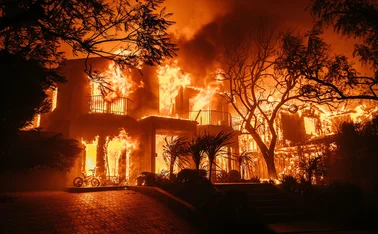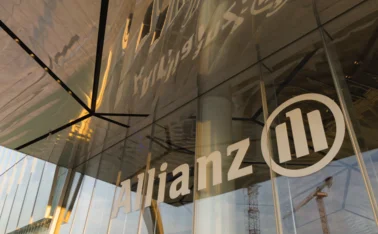
Fire Risks - Timber Frame: The burning issue

Timber frame construction has seen a massive resurgence in the past couple of years. Stefan Bramwell and Chris Dee look at the benefits and the risks involved.
The rapid rise in the use of timber frame construction has raised serious questions that the insurance and construction industries must address. There are significant benefits in using timber frames on construction sites but there are also particular risks attached to the use of the material. A number of high-profile fires have brought these issues to the fore. It is now important for insurers and brokers to address them and help contractors manage the emerging risks.
The growth in timber frame construction projects has certainly been impressive. Figures suggest that 35% of new builds in the UK are now timber frame, compared to 5% two years ago.
Essentially, there are three factors driving this growth. One is the fact that it is viewed as providing excellent environmental performance. Its green credentials mean the government is increasingly keen to use it in both private and municipal builds, such as new universities. Consequently, tenders for builds that use timber get a higher 'green' rating.
Time efficiency is also a factor. It is believed to be 20% faster to use timber on site than more conventional materials. There are also significant cost efficiencies to be gained.
Expanding applications
Timber is of course a material that has been in use for hundreds of years. The UK Timber Frame Association notes that there are open panel timber frame homes in Britain dating back to the 1800s. There is much consensus that, once completed, a timber frame building performs well and is a highly suitable material when used correctly. But the major risks lie in the construction phase and if a fire gets hold at this point the damage is likely to be extensive.
The problem insurers now face is that the rapid increase in the use of timber has gone hand-in-hand with its use in a wider variety of builds. In the 1960s and 1970s, its use was largely restricted to domestic properties. Now, though, it is being employed in commercial and municipal multi-storey buildings too. As a consequence, the cost of such fires can be significant. A multi-storey residential or office block that burns down, for example, results in greater losses than a single dwelling.
Given the clear advantages in using timber, its popularity is likely to continue rising. However, there is a sense that insurers and health and safety professionals have to play catch-up with the sudden and steep increase in the number of timber frame construction sites. To date, priority has largely been given to implementing health and safety measures that protect the personnel on site. There has been much activity from government, insurance industry and construction professionals to raise awareness of such risk management requirements. These initiatives are, of course, vital but it is now time to put the security of the site and its assets higher up the agenda.
While the focus is largely around the major fire potential, there are also wider liabilities to take into consideration. Burning timber can spread from the source to neighbouring properties as embers are blown and settle elsewhere. Undoubtedly, a number of timber frame fires have involved damage to surrounding buildings and property such as vehicles.
The potential liabilities can vary widely and the site location will clearly have an impact on the level of exposure. Green-field construction sites are inherently less risky than those in major conurbations. Fire spreading from one location to another does not automatically result in a liability claim, but a lack of effective site management could lead to allegations of negligence.
Associated exposures
Therefore, insurers must not only fully understand the exposures associated with the increasing popularity of timber frame construction but work with contractors to ensure adoption of risk management procedures on site that are more specific to timber. Current systems and site protection strategies do not always reflect the particular hazards related to modern timber frame construction.
There are lessons to be learned from Scandinavia, Germany and Austria, where timber has been widely used in construction for centuries and where specific procedures are better embedded.
Recent fires on construction sites — such as those in London's Camberwell in January this year and Peckham in November 2009 — where fire spread rapidly, have served to highlight the inherent dangers. These incidents also led to wider discussion on how to manage the risks. In particular, the London Assembly planning and housing committee is now conducting a review of fire safety in timber framed buildings. This will include a focus on buildings during the construction phase.
After the Peckham fire, the Chief Fire Officers Association and the Fire Protection Association released a joint statement calling on ministers to urgently implement the proposals from a recent report into this type of incident. One of the key recommendations was that, due the unique characteristics of timber frame construction sites, it is vital for fire and rescue services to be given early notification as to where and when this form of construction is to be used.
The UK TFA has been proactive in addressing the issues. The association recently published its 16 steps to fire safety on timber frame construction sites. This intends to promote best practice for the safety of site workers, the public and for the mitigation of loss from construction site fires. In February, the UK TFA also received backing from the CFOA for its 'Site Safe' initiative, which seeks to minimise the risk of fire on timber frame construction sites. And it has started to go further — talking about the potential for regular audits.
Lines of communication between the construction industry, the government and the insurance industry are very much open — and much of the dialogue ties in with wider fire issues. As a case in point, the Association of British Insurers produced a document in December that related to fires in general, but which also included a specific reference to timber framing. The ABI also held a House of Commons reception to publish new research showing that the cost of repairing fire damage has reached record levels. In its document Tackling fire: A call for action, the ABI highlighted several areas in need of improvement and made specific reference to timber frame.
Significant steps
So, there have certainly been some significant steps in the right direction. The whole issue of fire safety on construction sites is receiving a higher profile — and the challenges inherent in timber frame construction form an important part of the current discussions.
Similarities can be drawn between initiatives taken in the late 1980s and early 1990s, when increased instances of fires on construction sites led to the establishment of the Joint Code of Practice. This proved very effective and there is evidence that the advent of the JCOP served to reduce the number of fires. In fact, the seventh edition now includes a new Annex A specific to timber frame construction.
However, it is also important there is not a knee jerk reaction to the issues surrounding timber frame. The additional exposures are identifiable and action can be taken to minimise the loss potential. It is not necessarily a question of simply reducing capacity or increasing premiums. What is required is a measured approach — with insurers and brokers taking the time to fully understand the exposures and establish effective risk management strategies.
The good news is that construction clients are generally receptive to risk management measures and underinsurance is rarely an issue. Most of the main building contractors have extensive contract works and public liability programmes in place with substantial limits. The large contractors appoint senior personnel to ensure effective procedures are in place and are complied with — and they tend to work well with insurers' risk management experts.
Again, the JCOP is a testament to the industry's commitment to safety and security on site. It is certainly in contractors' and the industry's interests to avoid the bad press associated with even minor fires and, of course, to protect their own workforce.
It is also important to put the risks into context. Many of the challenges are relevant to all construction sites and not just timber frame projects. Arson, for example, remains a feature on many sites, whether they are timber or not. Security on timber frame construction projects needs to be just as vigilant as it is on other sites.
Furthermore, timber is an effective material and viewed by some as no more risky than other modern materials. However, the increased possibility of catastrophic losses remains. The first challenge is to fully understand the risks inherent in a material that is being increasingly used and the exposure an insurer has to timber frame in its account. Once this is understood, then insurers can start to help their insureds mitigate the risk.
Controlling risks
Although these risks cannot be mitigated by underwriting alone, the insured can be helped to control them through sound risk management. It is certainly preferable to reduce the number of losses through effective risk management rather than trying to offset greater losses through increased premiums. It will be important going forward that brokers are fully aware of the specific risks involved. A close working relationship between brokers, insurers and contractors will be vital.
There are, of course, many brokers that specialise in the construction industry who will be all too aware of the issues at stake. But insurers will also need to talk to their wider broker base to inform and educate them on the exposures specific to timber frames. Brokers may well see increased interest from insurers looking to explore the issues and work with them to understand the exposures.
It is likely that the popularity of timber frame in construction will continue to grow, as the benefits associated with the material become more widely recognised. The only possible deterrent to rapid growth could be an increase in headline-grabbing fires. It is, therefore, in the interests of all parties — construction, insurance and government — to gain an in-depth understanding of the specific exposures and to address these urgently. It will undoubtedly be a steep learning curve but the rise in timber frame construction should not be discouraged and should go hand in hand with excellent risk management.
Stefan Bramwell is the underwriting manager for Allianz Engineering and Chris Dee is the casualty manager at Allianz Commercial
Only users who have a paid subscription or are part of a corporate subscription are able to print or copy content.
To access these options, along with all other subscription benefits, please contact info@postonline.co.uk or view our subscription options here: http://subscriptions.postonline.co.uk/subscribe
You are currently unable to print this content. Please contact info@postonline.co.uk to find out more.
You are currently unable to copy this content. Please contact info@postonline.co.uk to find out more.
Copyright Infopro Digital Limited. All rights reserved.
As outlined in our terms and conditions, https://www.infopro-digital.com/terms-and-conditions/subscriptions/ (point 2.4), printing is limited to a single copy.
If you would like to purchase additional rights please email info@postonline.co.uk
Copyright Infopro Digital Limited. All rights reserved.
You may share this content using our article tools. As outlined in our terms and conditions, https://www.infopro-digital.com/terms-and-conditions/subscriptions/ (clause 2.4), an Authorised User may only make one copy of the materials for their own personal use. You must also comply with the restrictions in clause 2.5.
If you would like to purchase additional rights please email info@postonline.co.uk







